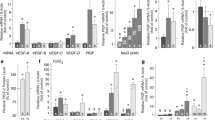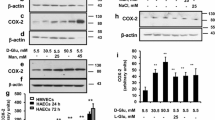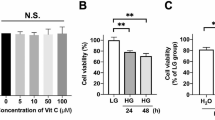Abstract
Background
Diabetic retinopathy is associated with osmotic stress resulting from hyperglycemia and intracellular sorbitol accumulation. Systemic hypertension is a risk factor of diabetic retinopathy. High intake of dietary salt increases extracellular osmolarity resulting in systemic hypertension. We determined the effects of extracellular hyperosmolarity, chemical hypoxia, and oxidative stress on the gene expression of enzymes involved in sorbitol production and conversion in cultured human retinal pigment epithelial (RPE) cells.
Methods
Alterations in the expression of aldose reductase (AR) and sorbitol dehydrogenase (SDH) genes were examined with real-time RT-PCR. Protein levels were determined with Western blot analysis. Nuclear factor of activated T cell 5 (NFAT5) was knocked down with siRNA.
Results
AR gene expression in RPE cells was increased by high (25 mM) extracellular glucose, CoCl2 (150 μM)-induced chemical hypoxia, H2O2 (20 μM)-induced oxidative stress, and extracellular hyperosmolarity induced by addition of NaCl or sucrose. Extracellular hyperosmolarity (but not hypoxia) also increased AR protein level. SDH gene expression was increased by hypoxia and oxidative stress, but not extracellular hyperosmolarity. Hyperosmolarity and hypoxia did not alter the SDH protein level. The hyperosmotic AR gene expression was dependent on activation of metalloproteinases, autocrine/paracrine TGF-β signaling, activation of p38 MAPK, ERK1/2, and PI3K signal transduction pathways, and the transcriptional activity of NFAT5. Knockdown of NAFT5 or inhibition of AR decreased the cell viability under hyperosmotic (but not hypoxic) conditions and aggravated the hyperosmotic inhibition of cell proliferation.
Conclusions
The data suggest that sorbitol accumulation in RPE cells occurs under hyperosmotic, but not hypoxic and oxidative stress conditions. NFAT5- and AR-mediated sorbitol accumulation may protect RPE cells under conditions of osmotic stress.








Similar content being viewed by others
References
Cunha-Vaz J, Ribeiro L, Lobo C (2014) Phenotypes and biomarkers of diabetic retinopathy. Prog Retin Eye Res 41:90–111
Kowluru RA (2005) Diabetic retinopathy: mitochondrial dysfunction and retinal capillary cell death. Antioxid Redox Signal 7:1581–1587
Zheng L, Kern TS (2009) Role of nitric oxide, superoxide, peroxynitrite and PARP in diabetic retinopathy. Front Biosci 14:3974–3987
Vinores SA, van Niel E, Swerdloff JL, Campochiaro PA (1993) Electron microscopic immunocytochemical demonstration of blood-retinal barrier breakdown in human diabetics and its association with aldose reductase in retinal vascular endothelium and retinal pigment epithelium. Histochem J 25:648–663
Aizu Y, Oyanagi K, Hu J, Nakagawa H (2002) Degeneration of retinal neuronal processes and pigment epithelium in the early stage of the streptozotocin-diabetic rats. Neuropathology 22:161–170
Xu H, Song Z, Fu S, Zhu M, Le Y (2011) RPE barrier breakdown in diabetic retinopathy: seeing is believing. J Ocul Biol Dis Inform 4:83–92
Omri S, Behar-Cohen F, Rothschild PR, Gélizé E, Jonet L, Jeanny JC, Omri B, Crisanti P (2013) PKCζ mediates breakdown of outer blood-retinal barriers in diabetic retinopathy. PLoS One 8, e81600
Énzsöly A, Szabó A, Kántor O, Dávid C, Szalay P, Szabó K, Szél Á, Németh J, Lukáts Á (2014) Pathologic alterations of the outer retina in streptozotocin-induced diabetes. Invest Ophthalmol Vis Sci 55:3686–3699
Klein R, Klein BE, Moss SE, Cruickshanks KJ (1998) The Wisconsin Epidemiologic Study of Diabetic Retinopathy: XVII. The 14-year incidence and progression of diabetic retinopathy and associated risk factors in type 1 diabetes. Ophthalmology 105:1801–1815
Kamoi K, Takeda K, Hashimoto K, Tanaka R, Okuyama S (2013) Identifying risk factors for clinically significant diabetic macula edema in patients with type 2 diabetes mellitus. Curr Diabetes Rev 9:209–217
UK Prospective Diabetes Study Group (1998) Tight blood pressure control and risk of macrovascular and microvascular complications in type 2 diabetes: UKPDS 38. BMJ 317:703–713
Adler AI, Stratton IM, Neil HA, Yudkin JS, Matthews DR, Cull CA, Wright AD, Turner RC, Holman RR (2000) Association of systolic blood pressure with macrovascular and microvascular complications of type 2 diabetes (UKPDS 36): prospective observational study. BMJ 321:412–419
Neuhofer W (2010) Role of NFAT5 in inflammatory disorders associated with osmotic stress. Curr Genomics 11:584–590
Hammes HP (2003) Pathophysiological mechanisms of diabetic angiopathy. J Diabetes Complicat 17(2 Suppl):16–19
Dagher Z, Park YS, Asnaghi V, Hoehn T, Gerhardinger C, Lorenzi M (2004) Studies of rat and human retinas predict a role for the polyol pathway in human diabetic retinopathy. Diabetes 53:2404–2411
Chung SS, Chung SK (2005) Aldose reductase in diabetic microvascular complications. Curr Drug Targets 6:475–486
Asnaghi V, Gerhardinger C, Hoehn T, Adeboje A, Lorenzi M (2003) A role for the polyol pathway in the early neuroretinal apoptosis and glial changes induced by diabetes in the rat. Diabetes 52:506–511
Cheung AK, Fung MK, Lo AC, Lam TT, So KF, Chung SS, Chung SK (2005) Aldose reductase deficiency prevents diabetes-induced blood-retinal barrier breakdown, apoptosis, and glial reactivation in the retina of db/db mice. Diabetes 54:3119–3125
He FJ, Markandu ND, Sagnella GA, de Wardener HE, MacGregor GA (2005) Plasma sodium: ignored and underestimated. Hypertension 45:98–102
Obika LO, Amabebe E, Ozoene JO, Inneh CA (2013) Thirst perception, plasma osmolality and estimated plasma arginine vasopressin concentration in dehydrated and oral saline loaded subjects. Niger J Physiol Sci 28:83–89
Kenney WL, Chiu P (2001) Influence of age on thirst and fluid intake. Med Sci Sports Exerc 33:1524–1532
Khaw KT, Barrett-Connor E (1988) The association between blood pressure, age and dietary sodium and potassium: a population study. Circulation 77:53–61
Qin Y, Xu G, Fan J, Witt RE, Da C (2009) High-salt loading exacerbates increased retinal content of aquaporins AQP1 and AQP4 in rats with diabetic retinopathy. Exp Eye Res 89:741–747
Hollborn M, Vogler S, Reichenbach A, Wiedemann P, Bringmann A, Kohen L (2015) Regulation of the hyperosmotic induction of aquaporin 5 and VEGF in retinal pigment epithelial cells: involvement of NFAT5. Mol Vis 21:360–377
Veltmann M, Hollborn M, Reichenbach A, Wiedemann P, Kohen L, Bringmann A (2016) Osmotic induction of angiogenic growth factor expression in human retinal pigment epithelial cells. PLoS One 11, e0147312
Klawitter J, Rivard CJ, Brown LM, Capasso JM, Almeida NE, Maunsbach AB, Pihakaski-Maunsbach K, Berl T, Leibfritz D, Christians U, Chan L (2008) A metabonomic and proteomic analysis of changes in IMCD3 cells chronically adapted to hypertonicity. Nephron Physiol 109:1–10
Cheung CY, Ko BC (2013) NFAT5 in cellular adaptation to hypertonic stress - regulations and functional significance. J Mol Signal 8:5
Moriyama T, Garcia-Perez A, Burg MB (1989) Osmotic regulation of aldose reductase protein synthesis in renal medullary cells. J Biol Chem 264:16810–16814
Miyakawa H, Woo SK, Dahl SC, Handler JS, Kwon HM (1999) Tonicity-responsive enhancer binding protein, a rel-like protein that stimulates transcription in response to hypertonicity. Proc Natl Acad Sci U S A 96:2538–2542
Park J, Kim H, Park SY, Lim SW, Kim YS, Lee DH, Roh GS, Kim HJ, Kang SS, Cho GJ, Jeong BY, Kwon HM, Choi WS (2014) Tonicity-responsive enhancer binding protein regulates the expression of aldose reductase and protein kinase Cδ in a mouse model of diabetic retinopathy. Exp Eye Res 122:13–19
Lin LR, Carper D, Yokoyama T, Reddy VN (1993) The effect of hypertonicity on aldose reductase, alpha B-crystallin, and organic osmolytes in the retinal pigment epithelium. Invest Ophthalmol Vis Sci 34:2352–2359
Sato S, Lin LR, Reddy VN, Kador PF (1993) Aldose reductase in human retinal pigment epithelial cells. Exp Eye Res 57:235–241
Chen R, Hollborn M, Grosche A, Reichenbach A, Wiedemann P, Bringmann A, Kohen L (2014) Effects of the vegetable polyphenols epigallocatechin-3-gallate, luteolin, apigenin, myricetin, quercetin, and cyanidin in retinal pigment epithelial cells. Mol Vis 20:242–258
Limb GA, Salt TE, Munro PM, Moss SE, Khaw PT (2002) In vitro characterization of a spontaneously immortalized human Müller cell line (MIO-M1). Invest Ophthalmol Vis Sci 43:864–869
An WG, Kanekal M, Simon MC, Maltepe E, Blagosklonny MV, Neckers LM (1998) Stabilization of wild-type p53 by hypoxia-inducible factor 1α. Nature 392:405–408
Arsenijevic T, Vujovic A, Libert F, Op de Beeck A, Hébrant A, Janssens S, Grégoire F, Lefort A, Bolaky N, Perret J, Caspers L, Willermain F, Delporte C (2013) Hyperosmotic stress induces cell cycle arrest in retinal pigmented epithelial cells. Cell Death Dis 4, e662
Fraser-Bell S, Kaines A, Hykin PG (2008) Update on treatments for diabetic macular edema. Curr Opin Ophthalmol 19:185–189
Latz E, Xiao TS, Stutz A (2013) Activation and regulation of the inflammasomes. Nat Rev Immunol 13:397–411
Yu Q, Stamenkovic I (2000) Cell surface-localized matrix metalloproteinase-9 proteolytically activates TGF-β and promotes tumor invasion and angiogenesis. Genes Dev 14:163–176
Natarajan K, Singh S, Burke TR Jr, Grunberger D, Aggarwal BB (1996) Caffeic acid phenethyl ester is a potent and specific inhibitor of activation of nuclear transcription factor NF-kB. Proc Natl Acad Sci U S A 93:9090–9095
Lee K, Lee JH, Boovanahalli SK, Jin Y, Lee M, Jin X, Kim JH, Hong YS, Lee JJ (2007) (Aryloxyacetylamino)benzoic acid analogues: a new class of hypoxia-inducible factor-1 inhibitors. J Med Chem 50:1675–1684
Schust J, Sperl B, Hollis A, Mayer TU, Berg T (2006) Stattic: a small-molecule inhibitor of STAT3 activation and dimerization. Chem Biol 13:1235–1242
Ruepp B, Bohren KM, Gabbay KH (1996) Characterization of the osmotic response element of the human aldose reductase gene promoter. Proc Natl Acad Sci U S A 93:8624–8629
Woo SK, Lee SD, Kwon HM (2002) TonEBP transcriptional activator in the cellular response to increased osmolality. Pflugers Arch 444:579–585
Ho SN (2003) The role of NFAT5/TonEBP in establishing an optimal intracellular environment. Arch Biochem Biophys 413:151–157
Mylari BL, Beyer TA, Siegel TW (1991) A highly specific aldose reductase inhibitor, ethyl 1-benzyl-3-hydroxy-2(5H)-oxopyrrole-4-carboxylate, and its congeners. J Med Chem 34:1011–1018
Burg MB, Ferraris JD, Dmitrieva NI (2007) Cellular response to hyperosmotic stresses. Physiol Rev 87:1441–1474
Henry DN, Frank RN, Hootman SR, Rood SE, Heilig CW, Busik JV (2000) Glucose-specific regulation of aldose reductase in human retinal pigment epithelial cells in vitro. Invest Ophthalmol Vis Sci 41:1554–1560
Virgili G, Parravano M, Menchini F, Evans JR (2014) Anti-vascular endothelial growth factor for diabetic macular oedema. Cochrane Database Syst Rev 10, CD007419
Miwa K, Nakamura J, Hamada Y, Naruse K, Nakashima E, Kato K, Kasuya Y, Yasuda Y, Kamiya H, Hotta N (2003) The role of polyol pathway in glucose-induced apoptosis of cultured retinal pericytes. Diabetes Res Clin Pract 60:1–9
Kubo E, Urakami T, Fatma N, Akagi Y, Singh DP (2004) Polyol pathway-dependent osmotic and oxidative stresses in aldose reductase-mediated apoptosis in human lens epithelial cells: role of AOP2. Biochem Biophys Res Commun 314:1050–1056
Fu J, Tay SS, Ling EA, Dheen ST (2007) Aldose reductase is implicated in high glucose-induced oxidative stress in mouse embryonic neural stem cells. J Neurochem 103:1654–1665
Bringmann A, Uckermann O, Pannicke T, Iandiev I, Reichenbach A, Wiedemann P (2005) Neuronal versus glial cell swelling in the ischaemic retina. Acta Ophthalmol Scand 83:528–538
Ryan GJ (2007) New pharmacologic approaches to treating diabetic retinopathy. Am J Health Syst Pharm 64:S15–S21
Author information
Authors and Affiliations
Corresponding author
Ethics declarations
Funding
The Geschwister Freter Stiftung (Hannover, Germany) and the Deutsche Forschungsgemeinschaft provided financial support in the form of grants (KO 1547/7-1). The sponsors had no role in the design or conduct of this research.
Conflict of interest
All authors certify that they have no affiliations with or involvement in any organization or entity with any financial interest (such as honoraria; educational grants; participation in speakers’ bureaus; membership, employment, consultancies, stock ownership, or other equity interest; and expert testimony or patent-licensing arrangements), or non-financial interest (such as personal or professional relationships, affiliations, knowledge or beliefs) in the subject matter or materials discussed in this manuscript.
This article does not contain any studies with human participants or animals performed by any of the authors.
Rights and permissions
About this article
Cite this article
Winges, A., Garcia, T.B., Prager, P. et al. Osmotic expression of aldose reductase in retinal pigment epithelial cells: involvement of NFAT5. Graefes Arch Clin Exp Ophthalmol 254, 2387–2400 (2016). https://doi.org/10.1007/s00417-016-3492-x
Received:
Revised:
Accepted:
Published:
Issue Date:
DOI: https://doi.org/10.1007/s00417-016-3492-x




